Coos ransomware (Free Guide) - updated Jan 2021
Coos virus Removal Guide
What is Coos ransomware?
Coos ransomware – a file-locking parasite made for cryptocurrency extortion
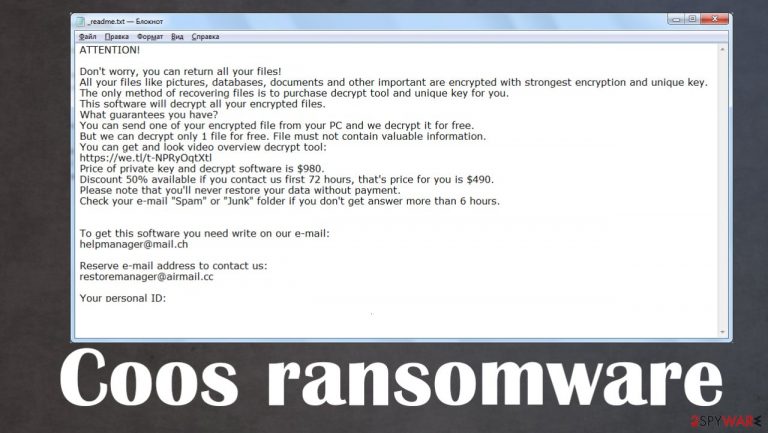
Coos ransomware is a new cryptovirus with a sole purpose – to shake down money from infected device owners. It does that by encrypting all non-system files with an army-grade RSA coding algorithm that renders the files inaccessible until a necessary decryption tool is used.
At the time of encryption, malware renames all personal victim files by appending a .coos extension. Afterward, it creates ransom notes, titled _readme.txt, and places them in every folder containing affected files. With these notes, assailants urge to contact them via given emails – helpmanager@mail.ch and restoremanager@airmail.cc and lay down instructions on what to do to regain control of the locked data.
This virus belongs to the pervasive Djvu ransomware family. File-locking viruses from this lineage were first detected in December 2018, and since then, new versions are submitted each week or even more often, e.g., since the beginning of this year, our team already wrote about four new variants – Qlkm, Omfl, and Igal.
If you are wondering how to decrypt your files without paying the attackers, the situation is rather dire. However, there are several alternative methods that you could try – we list them below. Emsisoft's decryptor might help some victims to recover all the lost data, although it might not happen immediately.
| name | Coos ransomware |
|---|---|
| Type | Ransomware |
| Family | Djvu |
| Appended file extension | All personal victim data (documents, databases, archives, etc.) is appended with a .coos extension |
| Ransom note | _readme.txt can be found in all affected folders |
| Criminal contact details | To establish contact, victims would need to contact their assailants via two given emails – helpmanager@mail.ch and restoremanager@airmail.cc |
| Ransom amount | The original decryption tool price (or the ransom amount) is $980, but if victims contact the criminals within 72 hours of encryption, a 50% discount is offered to lower the sum to $490 |
| Virus removal | Professional anti-malware software has to be used to completely and safely eliminate the cyber infection |
| System repair | Cryptoviruses from this family makes modifications to the system registry, host files, and other core settings. To restore your device to normal, please use the FortectIntego system repair tool |
Ransom notes of cyber infections from the Djvu family are all the same. They differ very slightly. It begins with an explanation that all files were locked and that the only way to unlock them is by purchasing their decryption tool. And then the part to convince the victim to do it begins.
Hackers offer victims to send them one encrypted file from the infected machine so they could decrypt it and send it back. Thus trying to prove that such a tool exists. Then they provide a link to a video where the deciphering tool can be seen in action.
And lastly, the creators of malware are offering a 50% discount on the ransom amount for victims that contact them within 72 hours of the cyberattack. That lowers the buyout from the original price of $980 to $490. People who fail to reach out to the perpetrators within the given timeline would have to pay the whole amount.
In other words, the threat actors are bending over backward to persuade their victims to act quickly and meet their demands. The whole message from _readme.txt ransom note reads:
ATTENTION!
Don't worry, you can return all your files!
All your files like pictures, databases, documents and other important are encrypted with strongest encryption and unique key.
The only method of recovering files is to purchase decrypt tool and unique key for you.
This software will decrypt all your encrypted files.
What guarantees you have?
You can send one of your encrypted file from your PC and we decrypt it for free.
But we can decrypt only 1 file for free. File must not contain valuable information.
You can get and look video overview decrypt tool:
https://we.tl/t-EtT4dX8q3X
Price of private key and decrypt software is $980.
Discount 50% available if you contact us first 72 hours, that's price for you is $490.
Please note that you'll never restore your data without payment.
Check your e-mail “Spam” or “Junk” folder if you don't get answer more than 6 hours.To get this software you need write on our e-mail:
helpmanager@mail.chReserve e-mail address to contact us:
restoremanager@airmail.ccYour personal ID:
–
Please don't give in to the cybercriminals' demands, as the only way to stop ransomware attacks is to stop paying its creators. Money gained from the victims motivates hackers to develop new, more sophisticated malware and finances their research for improved delivery techniques.

Victims that had their devices infected should remove Coos ransomware immediately. The best way to do it is by entrusting this task to professional anti-malware software such as SpyHunter 5Combo Cleaner and Malwarebytes. Only then people can rest assured that the infection is completely removed.
But before eliminating ransomware, users should consider exporting their encrypted files to an offline storage device, like a USB drive or other, because if there's no decryption software available now, it should be created sooner or later.
Once you get rid of the cryptovirus, it's time to take care of your device's overall health. Ransomware from the Djvu family is famous for making various alterations to the Windows registry, host files, and other important files/settings, so it's highly recommended to perform a system repair with a powerful system tune-up app like the FortectIntego.
Withhold from using file-sharing platforms to avoid cyber infections
Our research suggests that file-sharing platforms are a hotbed for Djvu family ransomware – it's the most popular spreading technique for file-locking parasites of this lineage. Torrent sites and other file-sharing platforms don't implement security measures to what people upload on their sites and what they're sharing.
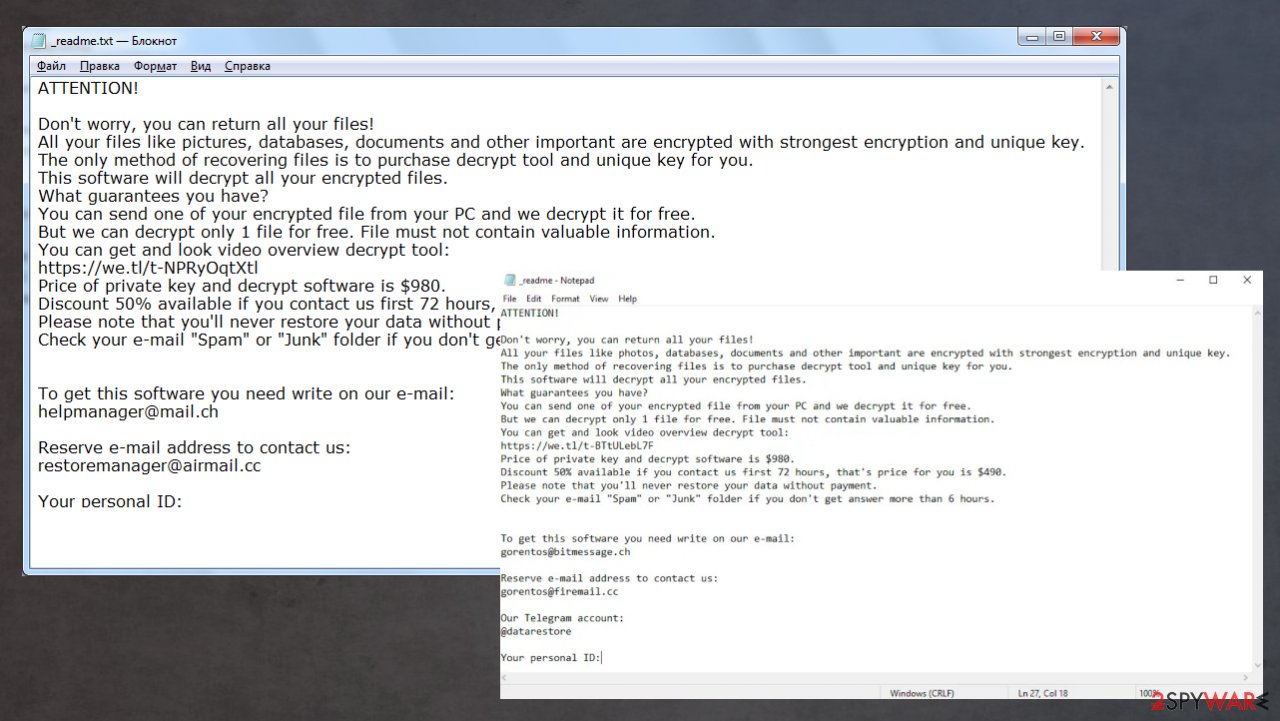
Cybercriminals love to exploit that by disguising ransomware as anything that would lure their next victims. It could be a crack for the latest game or a fake installer for an expensive piece of software. The camouflaged payload file of a cryptovirus can come in many forms:
- Text file
- Zip/Rar archive
- MS Office file
- An executable file, or practically any other file type.
As soon as an infected file is downloaded, and if your default or licensed anti-malware fails to detect it – it starts its bidding. To avoid this nightmare, users are urged to stop choosing to use pirated software, illegal activation toolkits, and similar items.
Methods to restore .coos virus files
Statistically speaking, most of the victims who did get infected with ransomware never dealt with such an intrusion before. Therefore, there are many misconceptions about this type of malware in general. For example, it is widely perceived that ransomware elimination with security software would once again provide access to the encrypted files. Unfortunately, it is not the case at all – you will not regain control of your data just by performing a full system scan with a security tool. So, what options do you have?
The answer to this question is rather difficult, as it depends on many factors. For example, if the virus failed to eliminate Shadow Copies on the system, data recovery should be easily possible. Data recovery software might also be useful in some cases, although it is unlikely to bring all files back.
Your best bet is to try Emsisoft's decryptor for STOP Djvu. It is very important to note that it only works for users whose data was locked with an offline key (this happens when malware fails to communicate with the attackers' servers). Even then, somebody has to pay the criminals, retrieve the key, and then share it with security researchers for them to add it to the decryptor's database. Thus, it might take some time before you can recover .coos files using it.
Nonetheless, we recommend you download the tool and perform a scan to check whether the decryption with it is at all possible. Here's how to do it:
- Download the app from the official Emsisoft website
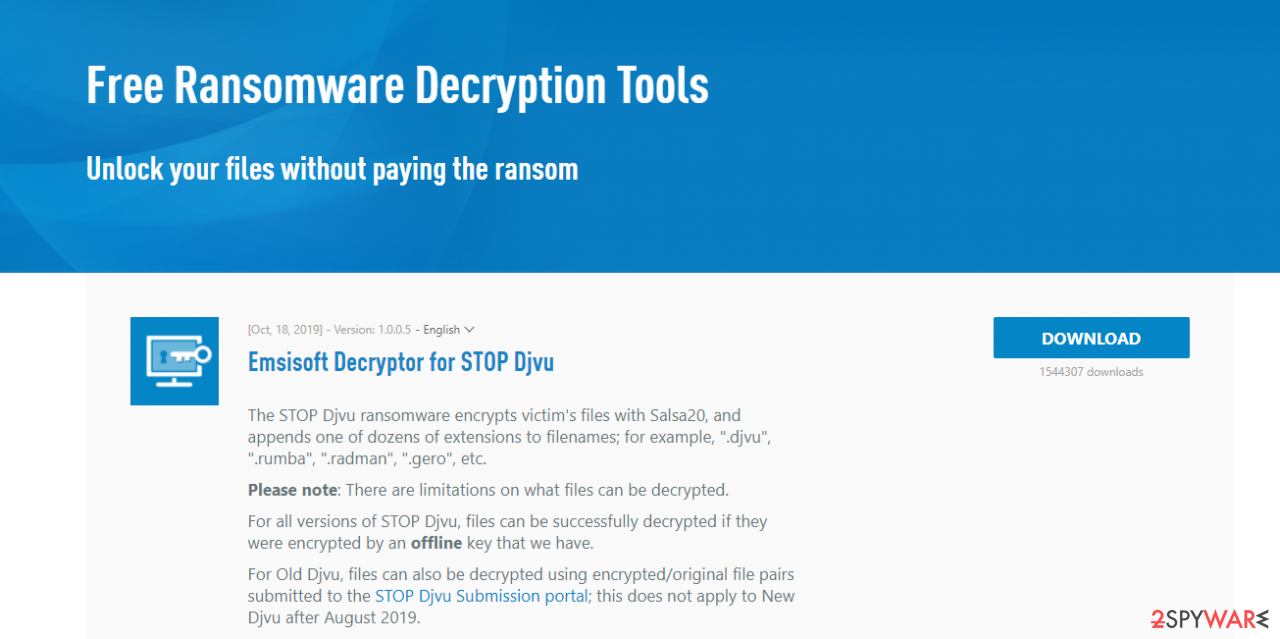
- After pressing Download button, a small pop-up at the bottom, titled decrypt_STOPDjvu.exe should show up – click it
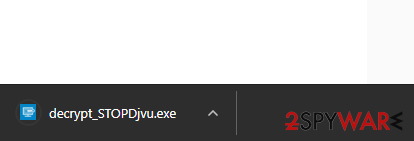
- If User Account Control (UAC) message shows up, press Yes
- Agree to License Terms by pressing Yes
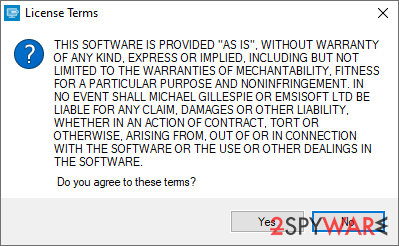
- After Disclaimer shows up, press OK
- The tool should automatically populate the affected folders, although you can also do it by pressing Add folder at the bottom
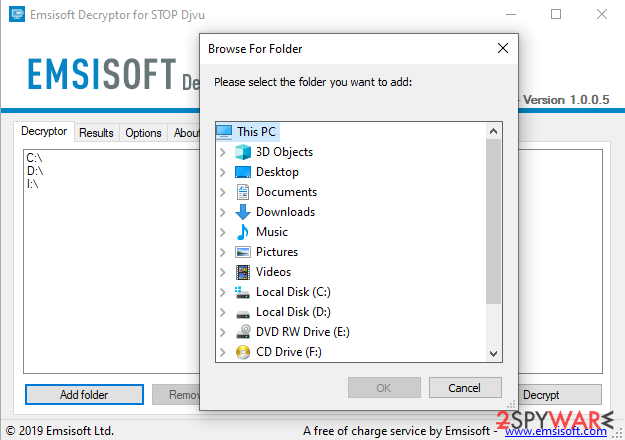
- Press Decrypt.
From here, there are three outcomes that are available:
- “Decrypted!” will be shown under files that were decrypted successfully – they are now usable again.
- “Error: Unable to decrypt file with ID:” means that the keys for this version of the virus have not yet been retrieved, so you should try later
- “This ID appears to be an online ID, decryption is impossible” – you are unable to decrypt locked files with this tool.
How to eliminate ransomware correctly
Ransomware attacks are on the rise, and they are not slowing down. Researchers predict,[1] that in 2021 this malware could cause more than $20 million in damages. So if you don't have a reliable anti-malware tool like SpyHunter 5Combo Cleaner or Malwarebytes, the time has never been better to get one.
Professional anti-virus software is needed not only to remove Coos ransomware but to prevent it from infecting the device. Virus databases of these type of apps should be updated every day because cybercriminals are relentless and develop new file-locking parasites constantly.
But please don't try to remove malware until you copied the essential encrypted files from your device to offline storage. There's no decryptor available now, but companies are committed to helping ransomware victims by constantly updating their decryption tools.
Once the files are extracted and the the virus removed, it's time to repair your system. This type of malware encrypts only personal data, but it does extensive damage to various system settings and files, including the system registry, host files, etc., to establish persistence.
If left neglected, these modifications could cause various abnormal behavior such as the blue screen of death,[2] overheating, overall performance loss, and so on. To restore any alterations that the virus has accomplished, experts[3] recommend using the FortectIntego system repair tool.
Getting rid of Coos virus. Follow these steps
Important steps to take before you begin malware removal
File encryption and ransomware infection are two independent processes (although the latter would not be possible without the former). However, it is important to understand that malware performs various changes within a Windows operating system, fundamentally changing the way it works.
IMPORTANT for those without backups! →
If you attempt to use security or recovery software immediately, you might permanently damage your files, and even a working decryptor then would not be able to save them.
Before you proceed with the removal instructions below, you should copy the encrypted files onto a separate medium, such as USB flash drive or SSD, and then disconnect them from your computer. Encrypted data does not hold any malicious code, so it is safe to transfer to other devices.
The instructions below might initially seem overwhelming and complicated, but they are not difficult to understand as long as you follow each step in the appropriate order. This comprehensive free guide will help you to handle the malware removal and data recovery process correctly.
If you have any questions, comments, or are having troubles with following the instructions, please do not hesitate to contact us via the Ask Us section.
IMPORTANT! →
It is vital to eliminate malware infection from the computer fully before starting the data recovery process, otherwise ransomware might re-encrypt retrieved files from backups repeatedly.
Scan your system with anti-malware
If you are a victim of ransomware, you should employ anti-malware software for its removal. Some ransomware can self-destruct after the file encryption process is finished. Even in such cases, malware might leave various data-stealing modules or could operate in conjunction with other malicious programs on your device.
SpyHunter 5Combo Cleaner or Malwarebytes can detect and eliminate all ransomware-related files, additional modules, along with other viruses that could be hiding on your system. The security software is really easy to use and does not require any prior IT knowledge to succeed in the malware removal process.
Repair damaged system components
Once a computer is infected with malware, its system is changed to operate differently. For example, an infection can alter the Windows registry database, damage vital bootup and other sections, delete or corrupt DLL files, etc. Once a system file is damaged by malware, antivirus software is not capable of doing anything about it, leaving it just the way it is. Consequently, users might experience performance, stability, and usability issues, to the point where a full Windows reinstall is required.
Therefore, we highly recommend using a one-of-a-kind, patented technology of FortectIntego repair. Not only can it fix virus damage after the infection, but it is also capable of removing malware that has already broken into the system thanks to several engines used by the program. Besides, the application is also capable of fixing various Windows-related issues that are not caused by malware infections, for example, Blue Screen errors, freezes, registry errors, damaged DLLs, etc.
- Download the application by clicking on the link above
- Click on the ReimageRepair.exe

- If User Account Control (UAC) shows up, select Yes
- Press Install and wait till the program finishes the installation process

- The analysis of your machine will begin immediately

- Once complete, check the results – they will be listed in the Summary
- You can now click on each of the issues and fix them manually
- If you see many problems that you find difficult to fix, we recommend you purchase the license and fix them automatically.

By employing FortectIntego, you would not have to worry about future computer issues, as most of them could be fixed quickly by performing a full system scan at any time. Most importantly, you could avoid the tedious process of Windows reinstallation in case things go very wrong due to one reason or another.
Restore Windows "hosts" file to its original state
Some ransomware might modify Windows hosts file in order to prevent users from accessing certain websites online. For example, Djvu ransomware variants add dozens of entries containing URLs of security-related websites, such as 2-spyware.com. Each of the entries means that users will not be able to access the listed web addresses and will receive an error instead.
Here's an example of “hosts” file entries that were injected by ransomware:

In order to restore your ability to access all websites without restrictions, you should either delete the file (Windows will automatically recreate it) or remove all the malware-created entries. If you have never touched the “hosts” file before, you should simply delete it by marking it and pressing Shift + Del on your keyboard. For that, navigate to the following location:
C:\\Windows\\System32\\drivers\\etc\\

Restore files using data recovery software
Since many users do not prepare proper data backups prior to being attacked by ransomware, they might often lose access to their files permanently. Paying criminals is also very risky, as they might not fulfill the promises and never send back the required decryption tool.
While this might sound terrible, not all is lost – data recovery software might be able to help you in some situations (it highly depends on the encryption algorithm used, whether ransomware managed to complete the programmed tasks, etc.). Since there are thousands of different ransomware strains, it is immediately impossible to tell whether third-party software will work for you.
Therefore, we suggest trying regardless of which ransomware attacked your computer. Before you begin, several pointers are important while dealing with this situation:
- Since the encrypted data on your computer might permanently be damaged by security or data recovery software, you should first make backups of it – use a USB flash drive or another storage.
- Only attempt to recover your files using this method after you perform a scan with anti-malware software.
Install data recovery software
- Download Data Recovery Pro.
- Double-click the installer to launch it.

- Follow on-screen instructions to install the software.

- As soon as you press Finish, you can use the app.
- Select Everything or pick individual folders where you want the files to be recovered from.

- Press Next.
- At the bottom, enable Deep scan and pick which Disks you want to be scanned.

- Press Scan and wait till it is complete.

- You can now pick which folders/files to recover – don't forget you also have the option to search by the file name!
- Press Recover to retrieve your files.

Create data backups to avoid file loss in the future
One of the many countermeasures for home users against ransomware is data backups. Even if your Windows get corrupted, you can reinstall everything from scratch and retrieve files from backups with minimal losses overall. Most importantly, you would not have to pay cybercriminals and risk your money as well.
Therefore, if you have already dealt with a ransomware attack, we strongly advise you to prepare backups for future use. There are two options available to you:
- Backup on a physical external drive, such as a USB flash drive or external HDD.
- Use cloud storage services.
The first method is not that convenient, however, as backups need to constantly be updated manually – although it is very reliable. Therefore, we highly advise choosing cloud storage instead – it is easy to set up and efficient to sustain. The problem with it is that storage space is limited unless you want to pay for the subscription.
Using Microsoft OneDrive
OneDrive is a built-in tool that comes with every modern Windows version. By default, you get 5 GB of storage that you can use for free. You can increase that storage space, but for a price. Here's how to setup backups for OneDrive:
- Click on the OneDrive icon within your system tray.
- Select Help & Settings > Settings.

- If you don't see your email under the Account tab, you should click Add an account and proceed with the on-screen instructions to set yourself up.

- Once done, move to the Backup tab and click Manage backup.

- Select Desktop, Documents, and Pictures, or a combination of whichever folders you want to backup.
- Press Start backup.

After this, all the files that are imported into the above-mentioned folders will be automatically backed for you. If you want to add other folders or files, you have to do that manually. For that, open File Explorer by pressing Win + E on your keyboard, and then click on the OneDrive icon. You should drag and drop folders you want to backup (or you can use Copy/Paste as well).
Using Google Drive
Google Drive is another great solution for free backups. The good news is that you get as much as 15GB for free by choosing this storage. There are also paid versions available, with significantly more storage to choose from.
You can access Google Drive via the web browser or use a desktop app you can download on the official website. If you want your files to be synced automatically, you will have to download the app, however.
- Download the Google Drive app installer and click on it.

- Wait a few seconds for it to be installed.

- Now click the arrow within your system tray – you should see Google Drive icon there, click it once.

- Click Get Started.

- Enter all the required information – your email/phone, and password.

- Now pick what you want to sync and backup. You can click on Choose Folder to add additional folders to the list.
- Once done, pick Next.

- Now you can select to sync items to be visible on your computer.
- Finally, press Start and wait till the sync is complete. Your files are now being backed up.
Report the incident to your local authorities
Ransomware is a huge business that is highly illegal, and authorities are very involved in catching malware operators. To have increased chances of identifying the culprits, the agencies need information. Therefore, by reporting the crime, you could help with stopping the cybercriminal activities and catching the threat actors. Make sure you include all the possible details, including how did you notice the attack, when it happened, etc. Additionally, providing documents such as ransom notes, examples of encrypted files, or malware executables would also be beneficial.
Law enforcement agencies typically deal with online fraud and cybercrime, although it depends on where you live. Here is the list of local authority groups that handle incidents like ransomware attacks, sorted by country:
- USA – Internet Crime Complaint Center IC3
- United Kingdom – ActionFraud
- Canada – Canadian Anti-Fraud Centre
- Australia – ScamWatch
- New Zealand – ConsumerProtection
- Germany – Polizei
- France – Ministère de l'Intérieur

If your country is not listed above, you should contact the local police department or communications center.
Manual removal using Safe Mode
Important! →
Manual removal guide might be too complicated for regular computer users. It requires advanced IT knowledge to be performed correctly (if vital system files are removed or damaged, it might result in full Windows compromise), and it also might take hours to complete. Therefore, we highly advise using the automatic method provided above instead.
Step 1. Access Safe Mode with Networking
Manual malware removal should be best performed in the Safe Mode environment.
Windows 7 / Vista / XP
- Click Start > Shutdown > Restart > OK.
- When your computer becomes active, start pressing F8 button (if that does not work, try F2, F12, Del, etc. – it all depends on your motherboard model) multiple times until you see the Advanced Boot Options window.
- Select Safe Mode with Networking from the list.

Windows 10 / Windows 8
- Right-click on Start button and select Settings.

- Scroll down to pick Update & Security.

- On the left side of the window, pick Recovery.
- Now scroll down to find Advanced Startup section.
- Click Restart now.

- Select Troubleshoot.

- Go to Advanced options.

- Select Startup Settings.

- Press Restart.
- Now press 5 or click 5) Enable Safe Mode with Networking.

Step 2. Shut down suspicious processes
Windows Task Manager is a useful tool that shows all the processes running in the background. If malware is running a process, you need to shut it down:
- Press Ctrl + Shift + Esc on your keyboard to open Windows Task Manager.
- Click on More details.

- Scroll down to Background processes section, and look for anything suspicious.
- Right-click and select Open file location.

- Go back to the process, right-click and pick End Task.

- Delete the contents of the malicious folder.
Step 3. Check program Startup
- Press Ctrl + Shift + Esc on your keyboard to open Windows Task Manager.
- Go to Startup tab.
- Right-click on the suspicious program and pick Disable.

Step 4. Delete virus files
Malware-related files can be found in various places within your computer. Here are instructions that could help you find them:
- Type in Disk Cleanup in Windows search and press Enter.

- Select the drive you want to clean (C: is your main drive by default and is likely to be the one that has malicious files in).
- Scroll through the Files to delete list and select the following:
Temporary Internet Files
Downloads
Recycle Bin
Temporary files - Pick Clean up system files.

- You can also look for other malicious files hidden in the following folders (type these entries in Windows Search and press Enter):
%AppData%
%LocalAppData%
%ProgramData%
%WinDir%
After you are finished, reboot the PC in normal mode.
Finally, you should always think about the protection of crypto-ransomwares. In order to protect your computer from Coos and other ransomwares, use a reputable anti-spyware, such as FortectIntego, SpyHunter 5Combo Cleaner or Malwarebytes
How to prevent from getting ransomware
Protect your privacy – employ a VPN
There are several ways how to make your online time more private – you can access an incognito tab. However, there is no secret that even in this mode, you are tracked for advertising purposes. There is a way to add an extra layer of protection and create a completely anonymous web browsing practice with the help of Private Internet Access VPN. This software reroutes traffic through different servers, thus leaving your IP address and geolocation in disguise. Besides, it is based on a strict no-log policy, meaning that no data will be recorded, leaked, and available for both first and third parties. The combination of a secure web browser and Private Internet Access VPN will let you browse the Internet without a feeling of being spied or targeted by criminals.
No backups? No problem. Use a data recovery tool
If you wonder how data loss can occur, you should not look any further for answers – human errors, malware attacks, hardware failures, power cuts, natural disasters, or even simple negligence. In some cases, lost files are extremely important, and many straight out panic when such an unfortunate course of events happen. Due to this, you should always ensure that you prepare proper data backups on a regular basis.
If you were caught by surprise and did not have any backups to restore your files from, not everything is lost. Data Recovery Pro is one of the leading file recovery solutions you can find on the market – it is likely to restore even lost emails or data located on an external device.
- ^ Steve Morgan. Global Ransomware Damage Costs Predicted To Reach $20 Billion (USD) By 2021. Cybersecurityventures. Cybersecurity news.
- ^ Blue screen of death. Wikipedia. The free encyclopedia.
- ^ Udenvirus. Udenvirus. Spyware and security news.
